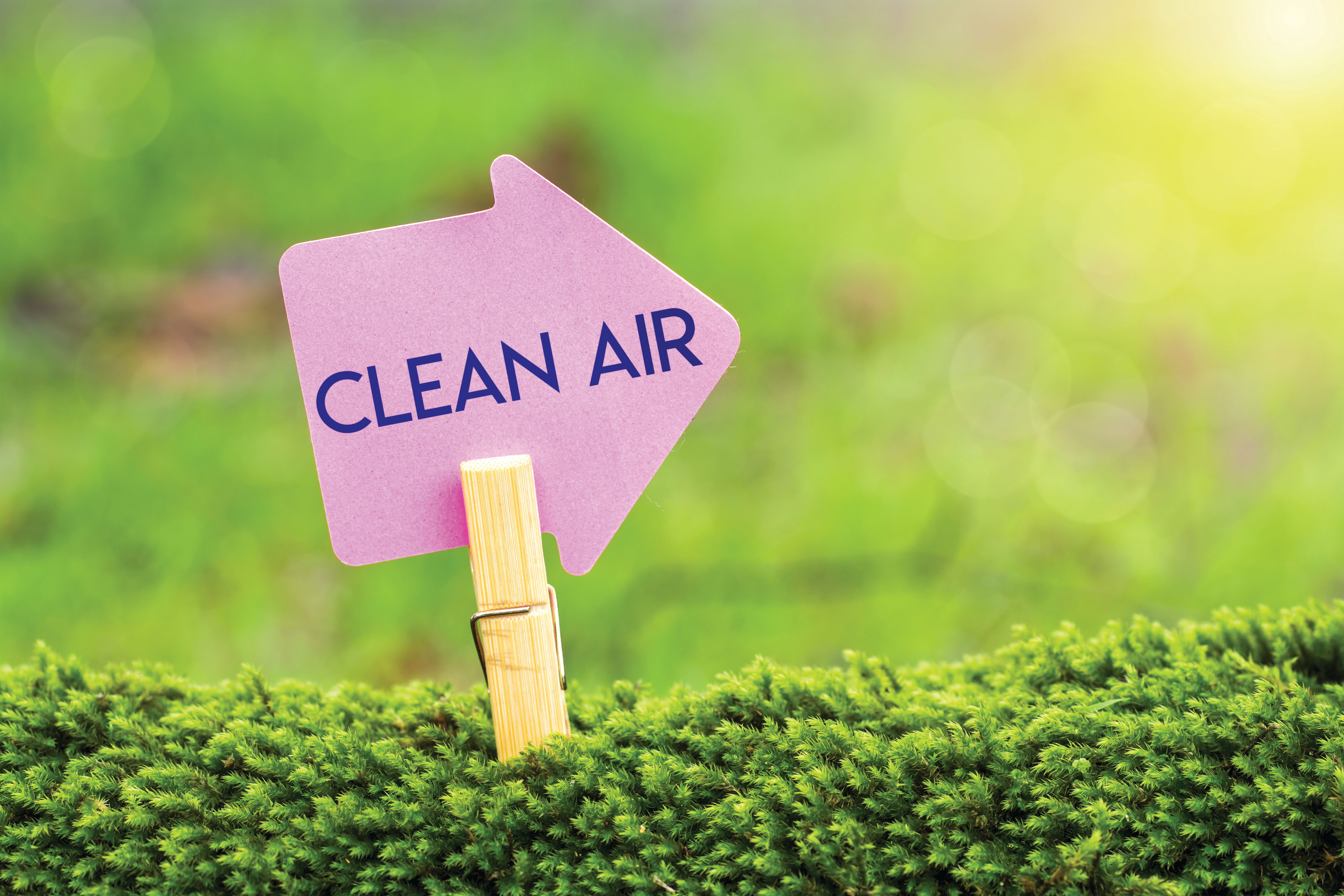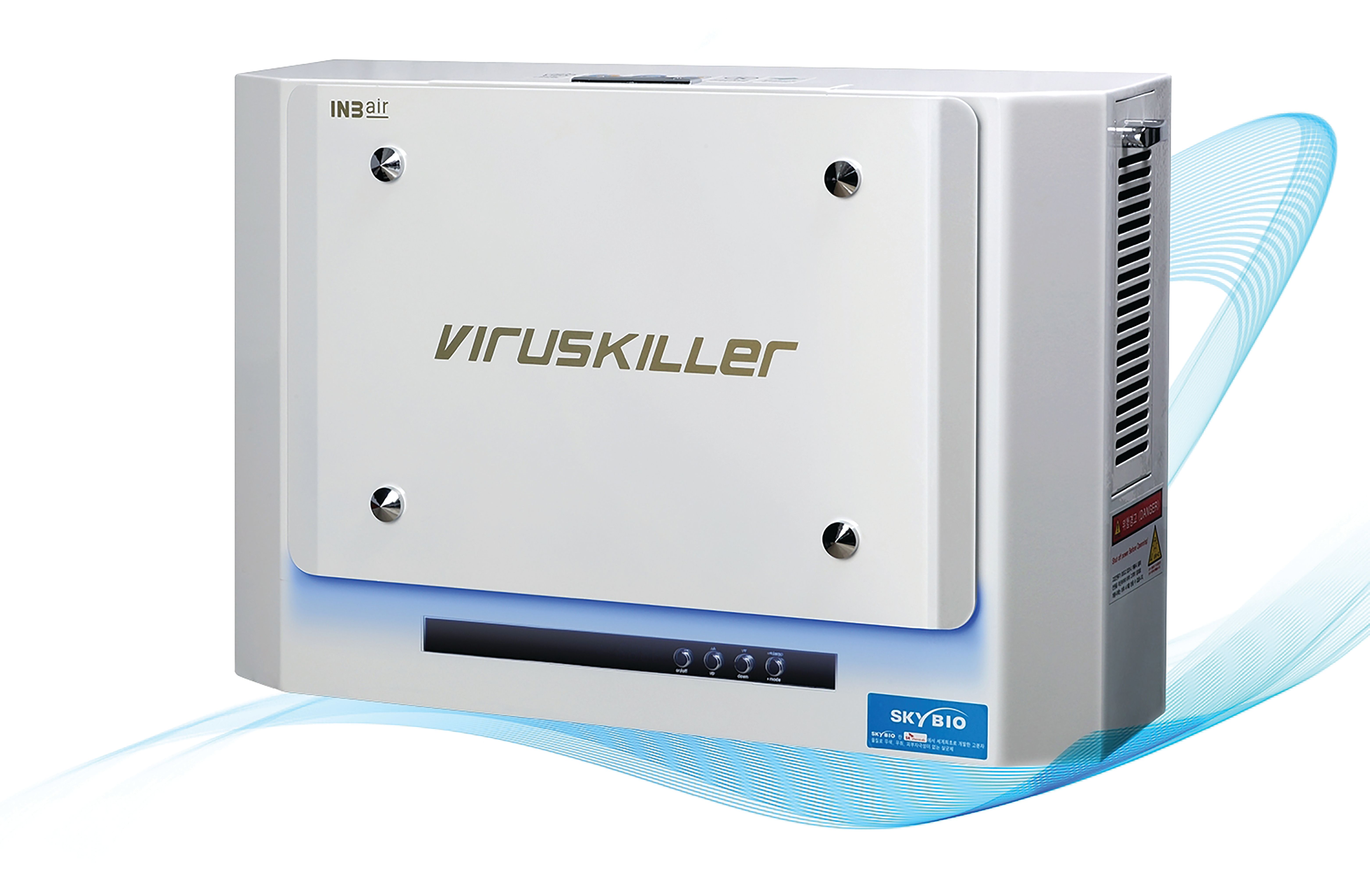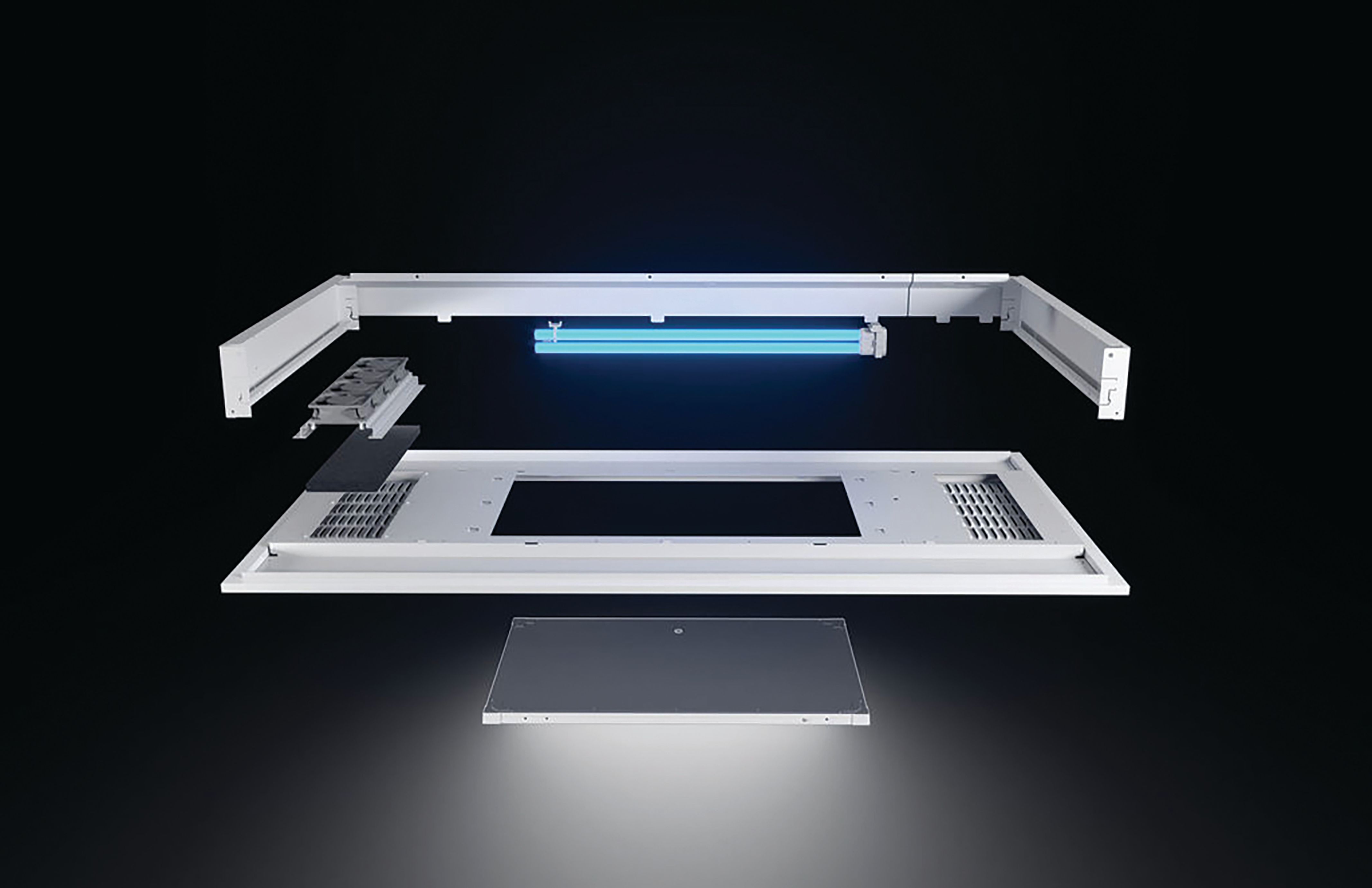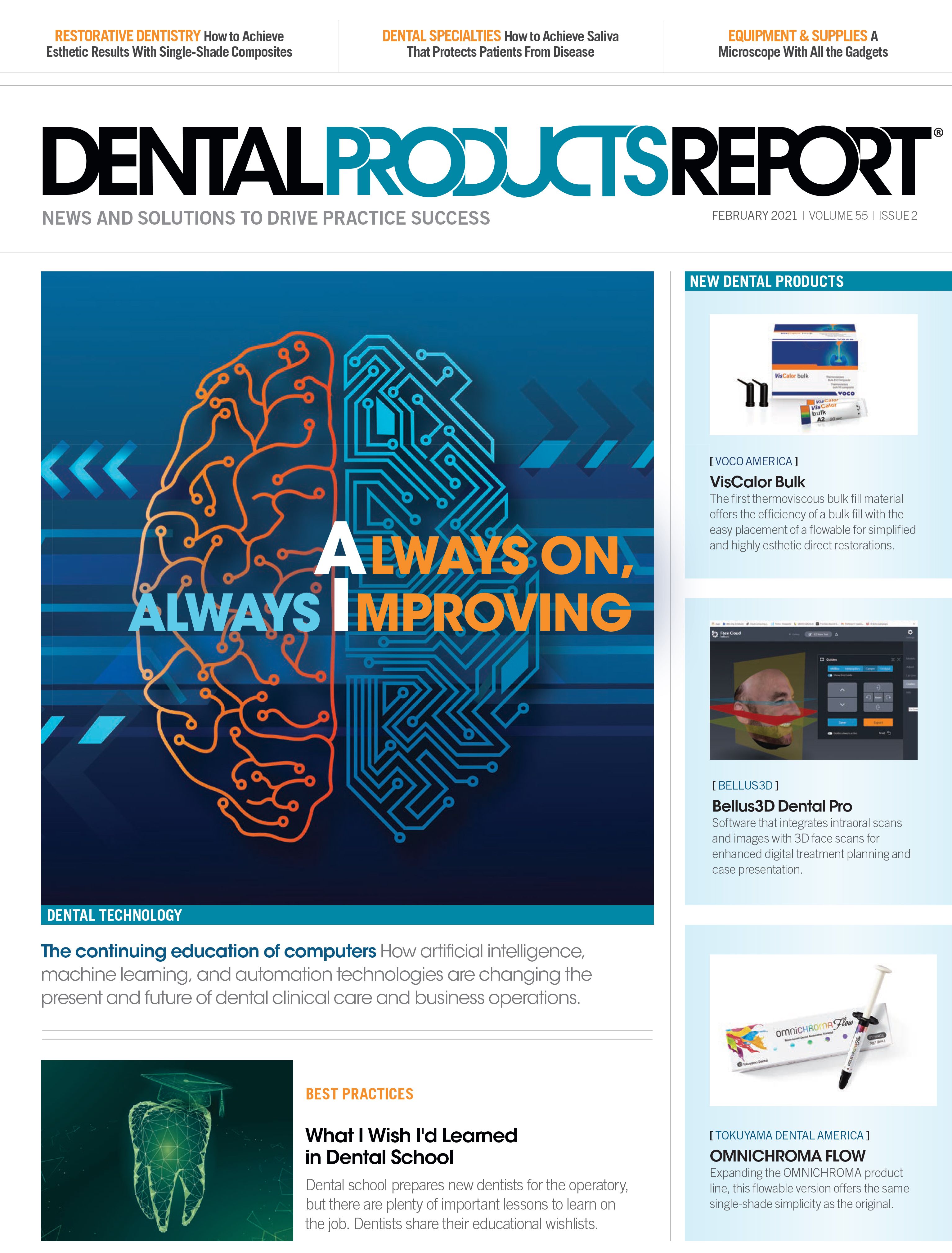Clearing the Air and Keeping It Clear
Dental office air filtration technology and science updates.
PHOTOAMIRI1 / STOCK.ADOBE.COM

Dentists are no strangers to aerosols and air contamination. In fact, based on the dental professional’s high levels of exposure to airborne disease pathogens and contaminants, the US Department of Labor’s Occupational Information Network database named dentists, dental hygienists, assistants, and dental lab techs as 4 of the 5 most damaging jobs to one’s health.1
The damage largely comes in the form of disease transmission via aerosols, a concern that has been elevated in light of the coronavirus disease 2019 (COVID-19) pandemic. Since the late 1960s, aerosols (< 50 µ) and splatter (> 50 µ) have been recognized as having the greatest potential to transmit infections.2 This means that controlling these aerosols and splatter is paramount to ensuring the health and safety of both the dental team and patients.
“COVID-19 elevated the topic of aerosol management and has forever changed how dental health care providers will practice,” says Michele Lash, BA, RDH, a clinical educator for Dentsply Sirona Preventive. “Dismissing the importance of aerosol reduction is no longer an option. We need to find a balance between providing the evidence-based therapies we know are beneficial for our patients to receive while integrating a multilayered strategy to address aerosol containment.”
Two major contributors in controlling aerosols in the dental practice are air filtration and ventilation. The American Society of Heating, Refrigerating and Air-Conditioning Engineers (ASHRAE) has reported that ventilation, filtration, and air-disinfection and -distribution technologies are capable of limiting environmental airborne pathogen transmission.3
“Aerosol-generating procedures are a constant risk when it comes to the spread of viral and bacterial pathogens in dental practices,” says Gary Severance, DDS, executive leader of professional services at Henry Schein Dental. “Pathogens from patients can remain in the air for hours after treatment, putting other patients and dental team members at risk of contracting illnesses.”
This makes air filtration and purification invaluable in controlling aerosols in the dental setting. Although dentistry has always been one of the health care professions whose practitioners are most aware of the importance of personal protective equipment (PPE), sterilization, and surface disinfection, the understanding and implementation of air filtration techniques are becoming more critical.
“Obviously, the current pandemic has brought to light that the next level of infection control required is source control, ventilation, and air purification,” Dr Severance says. “The dental profession requires as its very nature to work with patients unmasked and in close proximity to various team members while using aerosol-generating procedures.”
Three Important Steps
Source control of pathogens is the first, and perhaps the most effective, step to controlling air pollutants in the dental practice. Contamination risk can be mitigated through the use of high-volume evacuators, rubber dams, procedural rinses, and by limiting aerosol-generating procedures (AGPs).
Despite the efficacy of these source-control methods, however, ventilation and air purification steps are also critical to implement in the dental practice.
“You need to treat the air like you would a surface,” says Linda Lee, DrPH, MBA, chief medical affairs and science officer for UV Angel. “You’re washing hands and surfaces, but what are you doing for the air? I say to people, that’s the same air handler you had before the pandemic; you’ve updated your other protocols. Why haven’t you updated that? It’s about bringing awareness of what you need to do to the air.”
The Radic8 Viruskiller from Henry Schein combines an array of filtration techniques to make it more effective.

Dr Severance recommends that practice owners consult with their heating, ventilation, and air conditioning (HVAC) technician to increase filtering and performance in their current HVAC system and discuss options to increase airflow in mechanical ventilation systems. According to the Centers for Disease Control and Prevention (CDC), performing up-to-date maintenance and optimizing air-handling systems to ensure appropriate directionality and installation, filtration, and exchange rates can reduce the distribution of contaminants throughout the practice—thus better protecting patients and staff.4
Adding an air purification system such as an air filter, ionizer, or electronic particle cleaner can supplement the benefits of good source control and ventilation efforts. In areas where permanent air-handling systems aren’t an option, the CDC recommends adding a portable high-efficiency particulate air (HEPA) filtration system or other portable solution to augment the air quality.4
“Bundling or layering is best, since there isn’t just 1 solution for all situations,” Dr Severance explains. “You need source control, increased ventilation, and effective local air purification. In order to reduce risk to other patients and team members, air filtration or purification devices are very important safety systems to implement.”
Lash agrees.
“Many dental offices have adopted a multilayered plan of protective measures including air filtration systems, HVEs [high-volume evacuators], enhanced PPE, screen procedures, and preprocedural mouth rinses,” Lash says. “Each layer assists in minimizing risks and therefore increasing the confidence of both the dental teams and patients.”
Air Filters Defined
There are numerous types of air filtration and treatment systems available on the market. Most air purifiers (as well as extraoral suction devices) employ a combination of filters to effectively remove pathogens from the air. These include HEPA, minimum-efficiency reporting value (MERV), and carbon filters, and UV light.
HEPA filters are made of tightly woven minuscule glass fibers, designed to catch extremely tiny particles. They can remove up to 99.97% of dust, pollen, bacteria, and other airborne particles with a penetrating particle size of 0.3 µm. HEPA filters are also often used in chairside aerosol reduction products. However, filtration systems with HEPA filters tend to be louder, as it takes increased air speed to force air through the dense filter, so placement and location should be considered so that the decibel level isn’t negatively affecting patients or staff.
MERV is a rating system created by the ASHRAE, used to measure an HVAC filter’s ability to capture particles based on size. Classifications are broken down into 3 categories (0.3-1.0 µm, 1.0-3.0 µm, and 3.0-10.0 µm) and rated on a scale of 1 to 20. The higher the MERV score, the more effective the filter is at trapping particles. For example, filters with a MERV rating of 17 or above can trap the smallest sizes (0.03-1.0 µm) with 99.97% efficiency. MERV filters are often employed in conjunction with UV light treatment.
Carbon filters are particularly absorbent, and form a strong chemical bond with liquid, gaseous, and organic contaminants. According to studies, air purifiers employing activated carbon filters can more efficiently reduce airborne ozone than those without.4
UV germicidal irradiation (UVGI) uses UV light at a wavelength of 254 nm to disrupt nucleic acids in a microorganism’s DNA, inactivating the DNA and preventing it from replicating. The CDC’s 2007 Guideline for Isolation Precautions: Preventing Transmission of Infectious Agents in Healthcare Settings names UVGI as an effective supplemental air-cleaning method for reducing the transmission of airborne viral and bacterial infections.5 UVGI wavelengths can cause eye and skin irritation, so these lights require shielding when used in occupied rooms.
There are 2 primary types of UVGI systems: duct irradiation and upper-room air irradiation. Duct irradiation systems place UV lights inside the ducts that cycle outgoing air, disinfecting the air before it is recirculated. Upper-room air irradiation systems cycle air through a central chamber where pathogens are filtered and treated with UV light. They are mounted on the wall or ceiling, and can be used safely in occupied spaces.
“The fact that UVGI systems like the ones from UV Angel can be used in spaces that are occupied by people makes them unique,” Dr Lee notes. “As the pathogens are being generated, the air can be treated. It’s constantly running, 24/7. This cuts down on downtime between patients in the operatory, since the air is receiving continuous treatment, instead of episodic.”
One example of an upper-air system, the ceiling-mounted UV Angel Clean Air™, assumes the same footprint as a standard ceiling panel or light fixture. The system pulls air through its chamber every 0.7 seconds and treats the pathogens within with a patented UV-C light technology. Rather than using a dense HEPA filter, the Clean Air uses a MERV 6 filter that allows a lot of air to travel through the unit. The system purposefully uses this less dense filter and low cubic feet per minute (CFM) to allow pathogens significant exposure to the UV-C light to be sufficiently treated.
“A big benefit is that no one has to remember to turn it on or off, or move it [from] room to room,” Dr Lee says. “No one is going to trip over them since they are out of the way. Plus, it runs quietly in the background. The UV Angel runs at basically 50 CFM, because it’s very gently pulling things in the air that we’re most concerned about, which are…the pathogens, bacteria, and fungi.”
Although the Clean Air has not been tested against severe acute respiratory syndrome coronavirus 2 (SARS-CoV-2), it has proved effective against other coronaviruses and SARS-CoV-1, which share a similar genome. In prior laboratory studies, the system accomplished up to a 99.99% removal of pathogens.6 However, Dr Lee explains, those studies work with a set number of pathogens in a controlled environment—unlike in a dental office, where pathogens are constantly being generated and replaced in the air by aerosols produced from people talking or by dental procedures.
“If you think about active environments, you could never get 100% of pathogens out of the air, because they are constantly being produced,” Dr Lee says. “It’s like whack-a-mole; as soon as you clean the air, another pathogen has been generated. However, we get anywhere between a 60% and 80% reduction, which is pretty significant when you think about reducing the amount of pathogens in the environment.”
Combining for Success
To be truly effective in eliminating pathogens, air filtration systems need to be able to stop small particles. Because each filter brings its own benefits (but is not wholly effective by itself), many air filtration systems, such as the Cascade System and Jade Air Purification System (Surgically Clean Air), Radic8 Viruskiller™ (Henry Schein), and iAdaptAIr (Air Oasis), are combining an array of filtration techniques to make them more effective. For example, the Cascade and Radic8 Viruskiller attacks pathogens from all angles by combining different levels of filtration with UV-C light.*
“Many air purification systems simply use various filters to ‘filter out’ larger particles like dust, pollen, smoke, and some volatile organic particles, but then stop there,” Dr Severance remarks. “The Radic8 uses prefilters, HEPA filters, and activated carbon filters as its first line of defense. It then processes the air further through a reactor chamber to actively filter bioaerosols and pathogens.”
The first step of the process (when the air passes through the series of filters) traps large and ultrafine particles and pathogens. Air then moves into the reactor chamber, which consists of specialized hexagonal tubes coated in titanium dioxide. Within the chamber, organic and biological contaminants are exposed to UV-C lamps. This UV-C light reacts with the photocatalytic surface, and produces germicidal hydroxyl radicals. These powerful oxidants deactivate viruses, mold, bacteria, and fungi. The purified air is then delivered back into the room.
“The main feature to consider when choosing indoor air safety technology is single air pass kill rate rather than a system that recirculates the air without high-efficiency purification,” Dr Severance says. “Viruskiller technology has been tested against a large number of virus and bacteria strains and stimulants. More than just filtering out, [it has shown] in a single pass 99.9999% efficacy.”
Key Positioning
Many air filtration systems offer portable options that can be placed in operatories or waiting rooms to supplement air filtration. However, it’s important to note that they do not satisfy fresh air requirements, according to the CDC. The effectiveness of portable units is also closely dependent on the placement of the units, the location of exhaust and vents, and the configuration and occupancy level of the room.7
To ensure that air purifiers are performing optimally, several steps need to be followed:
Identify the location and directional flow (supply or return) of HVAC vents.
Determine the total volume of the room and identify the proper number of air changes per hour (ACH) for the space. ACH is determined based on the dimensions of the room and the device’s CFM. The CFM is the volume of air the system can move. (The CDC provides a handy chart to help calculate these numbers.4)
Check your HEPA filter’s CFM rating and determine the airflow direction in the room. Make sure the system is positioned so that it has access to the air in the room (ie, avoid tight corners or areas without much airflow).
In addition to these considerations, it’s important to remember that freestanding units are often bulky and can get in the way in operatories with limited space.
Filtering Forward
The bottom line is that air filtration is no longer something that can be ignored. Air pollution caused by aerosols is a growing health hazard that air filtration systems can help negate.
“This year, everyone has been made more aware how fragile we are in relation to airborne pathogens,” Dr Lee says. “Whether you are a dentist or a patient or a consumer, we’ve all been reminded how bad things can happen through airborne transmission. If we want to keep our staff and patients safe, we need to tackle air filtration effectively.”
The ceiling-mounted UV Angel Clean Air assumes the same footprint as a standard ceiling panel or light fixture.

In choosing the best air filtration or purification system for a practice, it’s crucial to select a system that can effectively, and efficiently, remove all types of pollutants, including bacteria, dust, and mold. Especially critical when dealing with the heightened risks from COVID-19, the system should also employ UV-C light to kill germs and viruses.
“I would caution any dental health care practitioner not to panic purchase,” Lash says. “Rather, take time to do homework and investigate beyond the features to determine if research supports its effectiveness and if the device meets the needs of the dental team.”
In the end, everyone agrees: the need for increased air filtration in the dental practice isn’t going away. Investing in a high-quality air filtration or purification system, in conjunction with following good PPE protocols and using intraoral aerosol reduction techniques, can assist in keeping everyone safe throughout the pandemic and beyond.
“I think we’re going to see a continuing focus on air filtration,” Dr Lee notes. “Because, quite frankly, this isn’t going to be our last pandemic. Many people who never gave a second thought to free-circulating viruses are now saying they want to get people—staff and patients—feeling safe. People don’t want to be caught off guard again, and we need to prepare our environments ahead of time for the long term.”
References
1. Kiersz A. The 27 jobs that are most damaging to your health. Business Insider. November 2, 2015. Accessed January 5, 2021. https://www.businessinsider.com/the-most-unhealthy-jobs-in-america-2015-11
2. Micik RE, Miller RL, Mazzarella MA, Ryge G. Studies on dental aerobiology. I. bacterial aerosols generated during dental procedures. J Dent Res. 1969;48(1):49-56. doi:10.1177/00220345690480012401
3. ASHRAE position document on infectious aerosols. ASHRAE. Accessed January 13, 2021. https://www.ashrae.org/file%20library/about/position%20documents/pd_infectiousaerosols_2020.pdf
4. Fisk W, Spears M, Sullivan D, Mendell M. Ozone removal by filters containing activated carbon: a pilot study. Office of Scientific and Technical Information. September 1, 2009. Accessed January 5, 2021.https://www.osti.gov/servlets/purl/1050670
5. Guideline for isolation precautions: preventing transmission of infectious agents in healthcare settings (2007). CDC. Updated July 22, 2019. Accessed January 5, 2021. http://www.cdc.gov/hicpac/2007IP/2007isolationPrecautions.html
6. Efficacy of ceiling mounted UV-C systems. UV Angel. May 15, 2020. Accessed January 5, 2021. https://uvangel.com/wp-content/uploads/2020/05/Efficacy-of-Ceiling-Mounted-Systems_v1_5.11.20.pdf
7. Interim infection prevention and control recommendations for healthcare personnel during the coronavirus disease 2019 (COVID-19) pandemic. CDC. Updated December 14, 2020. Accessed January 4, 2021. https://www.cdc.gov/coronavirus/2019-ncov/hcp/infection-control-recommendations.html
* Radic8 is not FDA cleared nor FDA approved. Marketed under the FDA’s Enforcement Policy for Air Purifiers, during the COVID-19 public health emergency. Tested on viruses that are representative of SARS-CoV-2, but not SARS-CoV-2 itself. This product is intended for medical purposes. It should be used as an adjunct to PPE and other infection control procedures. When using the Viruskillers, basic safety precautions should be observed, and instructions should be read to reduce the risk of fire, electric shock, or injury; the appliance should not be used by children or adults with reduced capabilities. Looking directly at a UV light may cause permanent damage to the eyes. For more information, please visit https://henryscheindigital.com/radic8.

Maximizing Value: The Hidden Benefits of Preventing Hospital-Acquired Pneumonia Through Oral Hygiene
September 10th 2024Originally posted on Infection Control Today. Hospital-acquired pneumonia (HAP) is a significant infection prevention concern, leading to high patient mortality, increased health care costs, and ICU usage. Oral hygiene is an effective preventive measure.